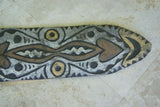KANINGARA CEREMONIAL SPIRIT BOARD SCARIFICATION CEREMONY SEPIK PAPUA NEW GUINEA
RARE
UNIQUE KANINGARA CEREMONIAL SPIRIT BOARD
USED DURING SCARIFICATION CEREMONY
FROM EAST SEPIK RIVER, PAPUA NEW GUINEA
KANINGARA CEREMONIAL SPIRIT BOARD
SCARIFICATION CEREMONY DISPLAY
FROM EAST SEPIK RIVER, PAPUA NEW GUINEA
Hand-carved original unique ceremonial spirit mask
Item 9A1
Collected in Kaningara 25 years ago
Measures: 24 1/4”x 6”
This was displayed among others in the men's house, during their important scarification ceremony, which culminates in the male son being finally freed from his mother’s blood, to which he was tied from birth on, in order to let the crocodile spirits of manhood enter his body, turning him into a man. This mask was displayed in the spirit house during the skin cutting ceremonies.
At that time, the boys being initiated resided in the Spirit House for 1-3 months, where they received training from the elders on how to be a man and how to embody the manly identity. They were subjected to the scarification rituals for days. Once the scarring is done, the boys’ cuts are filled with medicinal mud and herbs to aid in the healing of the scars. This ritual is done to symbolize strength and courage.
The men of Kaningara believed they should remain in their Spirit House for a major part of the day after the initiation rituals had taken place, to bond with other men, and prepare for raids against other tribes
The Kaningara people of Papua New Guinea live in a secluded jungle, a community of hunters and gatherers who regularly celebrate traditions and rituals that are crucial to their identities. One of these extremely important practices, which marks the transition from boyhood to manhood, is the tradition of skin cutting, or scarification. The Kaningara boys who undergo the ritual can be anywhere from 12-35 years of age. This is an expensive ritual symbolizing strength and survival, which takes families a long time to save money for. These rituals symbolize the expelling of the child at birth. This is why there are hundreds of small cuts made in the torso area, to expel blood from the mother and to allow the crocodile spirits of manhood to enter the male body. This symbolizes the divorce of young men from their mothers, and it prepares them for a symbolic transition into being “as strong as the crocodiles of the Sepik.”
Masks, statues and carvings of Papua New Guinea’s cultures serve a variety of spiritual, cultural and decorative purposes. Most of the carvings found in PNG are from the Sepik region, where the production and use of masks, among other things, is an important part of traditional culture. Ancestral masks, for example, represent deceased clan ancestors, totemic creatures that assist the tribe by interceding on a high plane to provide food, prevent and cure illness, while spirit masks embody tribal spirits who inhabit the surrounding jungle, & may come to the help of the tribe to counterattack sorcery spells meant to arm them.
Ancestors assist one's life by interceding on a high plane to provide food, prevent and cure illness, acquire stature, and counter sorcery attempted via the ancestor spirit plane. These are examples of beautiful rare original standing masks of Ancestral figures from Papua New Guinea (above and next page): hand-carved wood adorned with rattan basketry, cassowary feathers and hand-painted with clay-based colors, shell eyes & clan animal at the top.
If a village or clan has a lot of bad luck, the whole group may change their names and buy the rights to use masks from another clan in a different village in an attempt to fool the bad spirits or sorcerers. The resulting masks usually display characteristics of both groups. Each Sepik River village otherwise is independent and has a distinctive style. No two masks can ever be exactly the same either. Each is crafted by a different artist, representing a different ancestor or spirit, and is therefore unique. (As a matter of fact, copying is forbidden and sentenced by local law unless there is a formal agreement between the parties involved.)
The men carve masks from indigenous wood. Paint is made from earth pigments and charcoal. Masks can be decorated with shells, pig tusks, and Cassowary feathers. Few masks are worn directly over the face, which explains why many lack holes for eyes. They may be part of a large cone-shaped wicker framework for a dance costume called a tumbuan. Other masks are made only for display in the men's Haus to attract powerful and useful spirits. Masks often refer to a clan totem such as crocodile or eagle usually represented carved on the forehead. New masks may appear when a man dreams a spirit and carves a mask to represent it.























